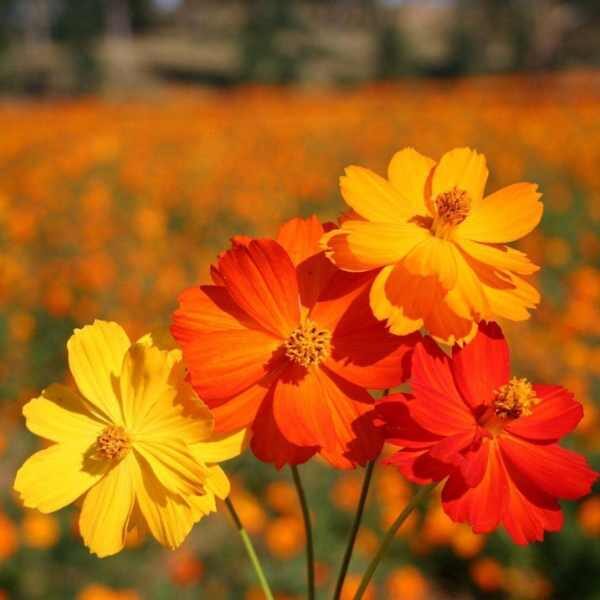Cosmos Bright Lights Mix
$4.49
Cosmos Sulphureus
- Seed Count 125
- Easy To Grow
- Annual
- Height 90 cm
In stock
Description
Whoever named this stunning cosmos cultivar got it just right! If you’re looking for a cosmos variety that is both beautiful and unconventional, Cosmos Bright Lights Mix may be the one for you.
This semi tall mix of yellow, gold, red and orange flowers will illuminate any corner of the garden and they thrive in bright, sunny growing areas.
Foliage is delicate, feathery green that gives an airy touch to the garden from midsummer to autumn.
The flowers are excellent for cutting and they are pollinator attractors with their long-lasting summer blooms.
It is an extremely resilient and versatile flower that tends to be very easy to grow from seed. Fairly pest free and low maintenance.
A great choice for gardening with children or less experienced gardeners, as simply broadcasting the seed will lead to excellent results.
The flowers of this variety are also notable for being edible unlike the more common cosmos varieties.
| Method: Sow direct or seedlings | Soil Temp: 10°C - 25°C |
| Cool Mountain: Nov - Dec | Germination: 7 - 10 days |
| Arid: Aug - Jan | Position: Part sun |
| Temperate: Sep-Nov, Mar-Jun | Row Spacing: 30cm apart |
| Sub Tropical: May - Oct | Planting Depth: 3 mm |
| Tropical: Jun - Aug | Harvest: 90 days |
Climate and Soil Requirements
Climate:
- Cosmos thrives in warm, sunny climates and is well suited to most regions in Australia.
Soil:
- Cosmos prefers well-draining soil with a pH between 6.0 and 8.0.
- It can tolerate poor soil conditions, including sandy or rocky soils, making it ideal for Australian gardens.
- Avoid overly rich or fertile soil, as this can lead to excessive foliage growth at the expense of flowers.
Planting Cosmos
Seed Sowing:
- Sow seeds directly into the garden bed or in seed trays.
- Scatter seeds on the soil surface and lightly cover with 3 mm of soil.
- Space seeds 30 cm apart to allow for growth.
- Water gently to avoid displacing the seeds.
Germination:
- Seeds typically germinate in 7=10 days.
- Keep the soil moist but not waterlogged during germination.
Transplanting:
- If starting seeds indoors, transplant seedlings outdoors once they are 10-15 cm tall and the weather is warm.
Care and Maintenance
Watering:
- Cosmos is drought tolerant once established.
- Water young plants regularly until they develop a strong root system.
- Mature plants only need watering during prolonged dry spells.
Fertilising:
- Avoid over fertilising, as this can reduce flowering.
- If necessary, apply a balanced, low nitrogen fertilizer once or twice during the growing season.
Deadheading:
- Regularly remove spent flowers to encourage continuous blooming.
- Deadheading also prevents self-seeding if you want to control the spread of Cosmos.
Pests and Diseases:
- Cosmos is relatively pest resistant but can occasionally attract aphids or spider mites.
- Treat infestations with insecticidal soap or neem oil.
- Ensure good air circulation to prevent fungal diseases like powdery mildew.
Companion Planting
Best Companion Plants
Vegetables:
- Tomatoes: Cosmos attracts pollinators like bees, which can improve tomato yields.
- Zucchini and Squash: Cosmos helps deter pests like aphids and whiteflies.
- Beans: The tall, airy structure of Cosmos provides light shade for beans without competing for nutrients.
Herbs:
- Basil: Cosmos and basil grow well together and attract beneficial insects.
- Dill: Both plants attract hoverflies, which prey on aphids.
Flowers:
- Marigolds: Marigolds repel nematodes and other pests, while Cosmos attracts pollinators.
- Zinnias: These flowers share similar growing conditions and create a vibrant, colourful garden.
- Sunflowers: Cosmos can fill in gaps around sunflowers and attract pollinators.
- Lavender: Both plants thrive in sunny, well-draining conditions and attract pollinators.
- Nasturtiums: These act as a trap crop for aphids, protecting Cosmos and other plants.
Plants to Avoid:
- Avoid planting Cosmos near plants that require rich, fertile soil, as Cosmos thrives in poorer conditions.
- Keep Cosmos away from aggressive growers that may overshadow or outcompete it.
Harvesting and Saving Seeds
Harvesting Flowers:
- Cut Cosmos flowers in the morning when they are fully open.
- Place them in a vase with fresh water for a long-lasting display.
Saving Seeds:
- Allow some flowers to remain on the plant until they fade and dry out.
- Collect the dried seed heads and remove the seeds.
- Store seeds in a cool, dry place for planting next season.
Troubleshooting Common Issues
Leggy Plants:
- Caused by insufficient sunlight.
- Ensure Cosmos receives at least 6 hours of direct sun daily.
Poor Flowering:
- Over fertilisation or overly rich soil can reduce blooms.
- Stick to low nitrogen fertilizers.
Self-Seeding:
- Cosmos can self-seed prolifically.
- Deadhead regularly to control spread.
Postage Charge
Orders under $30 attract a $4.50 shipping charge. Orders $30 and above have free shipping.
Order Times
Seed orders are normally dispatched within three business days. You will receive an email when seeds are mailed out.
Postage Days
Seeds are mailed out Monday to Friday at 1pm. Except for the Friday of long weekends.
Postage Times
WA 2-3 Days: SA,NT 3-5 Days: NSW, ACT, QLD, VIC: 5-7 Days
Carrier
We use Australia Post Letter Postage for the majority of orders
Not only are our seeds packed in recycled paper envelopes, we keep the theme going when we post out website orders. To protect your seeds from moisture and the letter box munchers (snails), we use a very special plastic free material made from plants. They are then put into recycled mailing envelopes. Green all the way 💚🌿












Reviews
There are no reviews yet